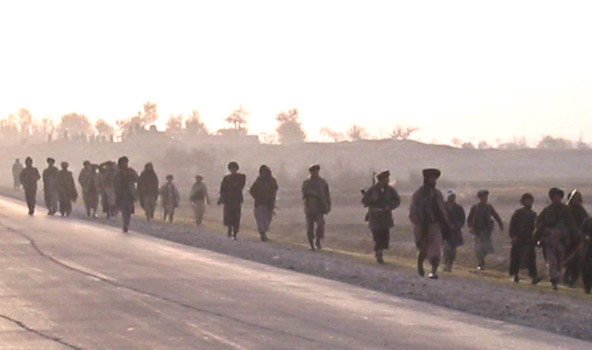
26 November 2001. Kunduz, Afghanistan. Northern Alliance fighters prepare to take Kunduz in the early morning. The Taliban would fight a fierce defensive action to allow their forces to retreat toward Mazar-i-Sharif.
Photo: Phillip Robertson
We get back in the truck and Kandahar heads west, away from the mountains, down the remains of a decent road which is where we start to see Khan's fighters, there are more of them as we go forward, but we are forced to inch along because of the terrain. We follow a river and come around a bend with the high walls of the valley rising above us. Where there was no one, there are now thousands of armed tribesmen, all of them wearing wool pakuls and shawls waiting for orders. They are happy because they know they are going to win after a decade of fighting against men who are not in the least afraid of death. They are from the seventh century with 20th century weapons.
A fighter stops Kandahar and directly in front of the Toyota is an old man leading a saddled and rider-less white stallion which belongs to the general Khan. The old man's only duty to keep it in sight at all times, the old man solemnly marked the furthest extent of Northern Alliance forces. We were not allowed to pass the horse because that would have put all of us at the front of the column and this was not proper, Kandahar drives back down the hill to the river to wait. The general would be first. Donovan has a pair of binoculars and we look west to Taloqan and see nothing, and then the air raids begin and the dust blooms in strange flowers on the horizon.
At the base of the hill, Daoud Khan talks to his commanders and comes to a decision. In a few minutes the jeeps are moving and we have to run down the hill to meet up with Kandahar. I am separated from the others. Sion is taking photographs of the men. Donovan disappears with the translator. There is nothing to do but walk around among the soldiers. They are excited but speaking quietly and when I pass them they nod. I walk west and find the furthest extent of the front, twenty fighters sitting on the ground next to a jeep. A few yards away from my feet the pebbles jump in the air, a clicking seizure, and there's the sound of the bullet hitting the creek bed but no sound of a shot. The sniper is up in the hills above the Northern Alliance forces and it feels like time to get behind the jeep before he can put another round in the chamber. The Afghans laugh and stay where they are, and I walk over and sit down with them and they form a circle around me. One man speaks a few words of English, pointing out where the shot came from, a mountain of dust scarred by artillery shells. A red-haired man, Nazir Mohammed, takes the lapel of my coat, opens it and makes a big show of looking for the bullet hole. Nazir is the commander of ten Mujahedin who ride with him in a jeep. The fighters are ready, and when the order comes they climb into anything that rolls. The order is a shout, Allahu Akhbar, which goes through them like a current and a thousand men jump into their trucks and tanks. Engines start. Diesel fuel and the metal sounds of the guns being taken off their safeties. Nazir Mohammed and his men then pull me up into his jeep and we join the column, heading west toward Taloqan. Below us, the river is a bright band that is white where it goes over rocks.
As the column passes through a steep canyon, a jackhammer sound starts up, a machine gun hammering in long paragraphs from high up in a gully that looks down on the road, a perfect place for the ambush which sends the column into chaos, Khan's Russian trucks are turning around, facing the wrong direction, causing a traffic jam. Fifty feet in front of Nazir's jeep, the fighters in a truck with a Russian antiaircraft gun point it at the gully and open up on the hill, scanning it, but the Taliban gunners are now running up toward the ridge, and two fighters get out and head after them. There is a burst of gunfire from two of Khan's men with the Kalashnikovs and it's over. We do not see the killing. We move forward.
Another fifty feet and there's one black boot is in the middle of the road in a pool of
blood with the man's foot still in it, the rest of him somewhere else. Nazir steers around
it. The Taliban have retreated after a small holding action where the men volunteered to
die and they have disappeared, there is nothing else left to do but move. The column of
trucks enters the town. On the outskirts of Taloqan, hundreds of men and boys are waiting
to greet the fighters and they are shouting, and the fighters are shouting the name of God
holding their weapons up in the air. As we come up to the city, the crowd swells until it
surges over the trucks and the tanks, the kids climb up and the fighters lift them in.
People waiting by the side of the road begin throwing coins and bills into the air to the
men, a rain of coins bouncing off the metal of the cars then landing in the street.![]()
 LEAD IMAGE: 26 November 2001. Kunduz, Afghanistan. Northern Alliance fighters on the road to Kunduz.
LEAD IMAGE: 26 November 2001. Kunduz, Afghanistan. Northern Alliance fighters on the road to Kunduz.Photo: Phillip Robertson
© Phillip Robertson, 2009-2020.
